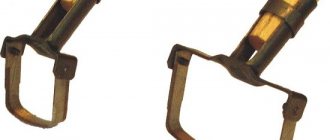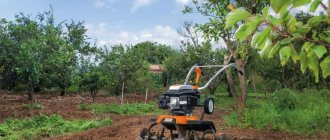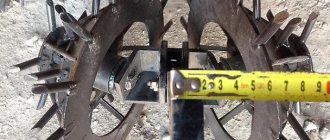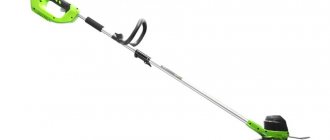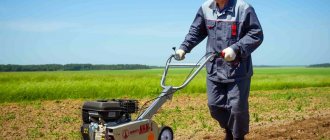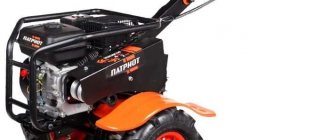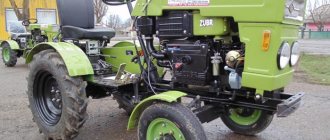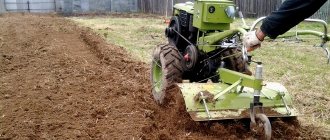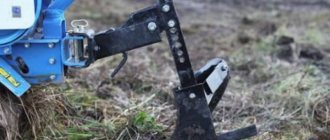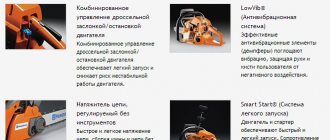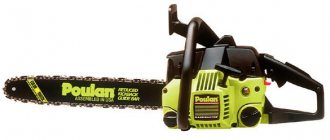To cultivate a garden you need reliable and lightweight tools. One of them is a hand-held gardening device called “Strizh”. With the help of such a weeder you can significantly reduce the time you spend working in your garden.
To cultivate a vegetable garden you need reliable and lightweight tools (Photo used under standard license ©ogorodnye-shpargalki.ru)
Manual weed cultivator Strizh: models and how to make it yourself
Owning a personal plot involves not only outdoor picnics on weekends, but also carrying out certain soil cultivation work . Naturally, this applies to those who also use their dacha as a means to grow their crops.
It is for these purposes that special motorized tools were manufactured to simplify and speed up the process of cultivating and plowing land.
However, not every person can afford to purchase such a means of small-scale mechanization as a cultivator or walk-behind tractor.
Increasingly, people are trying to make these units themselves, using available tools and materials.
One of the most popular and sought-after products in this class is the Strizh weed cultivator , which is quite effective in operation if it is in capable hands.
- 1 About the manufacturer
- 2 Models
- 3 DIY production
- 4 Conclusion
About the manufacturer
But there are other types of equipment on sale that belong to the class of hand cultivators. They are much cheaper than motorized units, such as: Mole, Tarpan, Loplosh, Patriot, Champion, Texas, Viking, which justifies the choice in their favor.
The Swift cultivator is a fairly simple and uncomplicated device in its design. As for the manufacturer itself, this company began its activities in 1992, manufacturing and selling various gardening tools.
The main feature of this product is that the edge of these tools is made in such a way that it remains sharp for a very long time, or sharpens itself during its use. Clearly visible in the photo:
Only high-quality steel is used in production, so all tools are of exceptionally high quality and reliability. The company's assortment includes various products, which can be divided into two categories:
- Gardening tools.
- Tools for removing ice and snow.
The first category includes various hoes, shovels, weeders, root removers, flat cutters, etc. To remove snow and ice, the company's specialists manufactured various scrapers and sharply sharpened ice picks.
Over its history, the company's products have gained popularity not only in our country, but also in countries near and far abroad.
For more information about the Swift cultivator, watch the video:
Models
As for Strizh cultivators, their lineup is quite modest. In total, there are two types of this tool - small and large, which differ in weight and processing width. The small manual cultivator Strizh has a width of 65 mm, and a large one – 120 mm.
The use of one or another device is determined by how far the plants are planted from each other (you can read about the distance between rows when planting potatoes here).
Accordingly, if the distance is small, then it is best to use a small weeder and vice versa.
After plowing the ground with a plow, the soil should be leveled. To do this, you need a harrow for a walk-behind tractor, which will simplify your work and save time and effort.
KamAZ-55111 is the leader in terms of the number of vehicles produced among representatives of its class. Here is some useful information about this dump truck.
For any type of heavy work, only additional equipment always helps. The garden cart is your indispensable assistant in construction and gardening.
I would also like to say something about the knives of these devices. In their production, a special edge hardening technology is used, which allows you to work with the tool for a long time without fear that it will become dull.
In general, these knives are self-sharpening , i.e. They are sharpened during the work process, but it wouldn’t hurt to sharpen them yourself when the new season comes.
Due to their design, cultivation of the land using these manual cultivators can be carried out in the reverse and forward directions.
The knives are quite thin, but this is only an advantage, because they penetrate the ground better and more freely, simplifying the process of cultivating the soil.
These cultivators are hand tools, so you need to take care of the correct handle for these devices. Not only the efficiency of work, but also the fatigue of the body during work will depend on how well it corresponds to the height of a particular person.
After all, if the handle is too short, then a person will have to bend down to work with it, and this will lead to the fact that he will get tired very quickly. In addition, the handle must be smooth, without splinters, so that the person does not get hurt during work.
In general, thanks to the Strizh manual cultivator, you can carry out a whole range of work:
- loosening the soil using a non-mouldboard method;
- tillage;
- removal of weeds, weeds and other vegetation;
- pruning plants at a depth of up to 60 mm;
- Using this device, you can form furrows for planting various vegetables and herbs.
With all this, the cost of manual Strizh cultivators is quite low - from 300 to 500 rubles.
DIY making
making this device yourself is not advisable .
Due to the fact that self-assembly of this or that unit is started precisely for the sake of saving money on the purchase of a finished device, it is hardly necessary when the price of the issue is no more than five hundred rubles - this is how much the Strizh manual cultivator costs.
However, if you still decide to try to make a manual cultivator with your own hands, then for this you will need a steel sheet from which you need to cut four strips, as well as a crown from an old shovel. One strip of metal sheet, which will be located at the bottom of the structure, must be sharpened very carefully.
Using welding, we connect all the cut strips , resulting in a rectangle. We also weld a shovel crown on top, into which we insert a pre-prepared handle. In principle, this is the entire process of making a homemade hand cultivator yourself.
Conclusion
The Strizh manual cultivator is a fairly effective device for cutting weeds and loosening the soil in a personal plot. The low cost of such devices makes them very accessible to all categories of citizens involved in agriculture.
This is very important, because purchasing motorized equipment is not accessible to all people, but with the help of similar manual units one can perform similar work.
We recommend a review of the best walk-behind tractors.
Source: https://MachinSpec.com/selskoxozyajstvennaya/kultivator/strizh.html
Typical flat cutter or Fokina weeder
Many held in their hands a tool for cutting soil and weed roots, shaped like a poker - a flat cutter with a sharply sharpened knife located at an angle to the handle. And few people know that all models with a similar shape are analogues, while the original is the weeder of engineer Fokin. Limited capacity after a heart attack prompted him to develop for himself the most convenient and effective instrument, capable of performing many different operations.
Engineer Fokin's Pololnik
In particular, a flat knife with two sharp edges, located at an angle to the handle, allows you to cut plants like a scythe. In this case, the base of the cutting part of the Fokin flat cutter, curved downward in an arc, easily bites into the ground, leaving behind a loosened groove. Actually, the tool has 3 sharp edges, one of them falls on another edge of the plate, the end edge, farthest from the handle. Slightly beveled, it can easily go into the ground if the tool is used as a narrow hoe. You can see Fokina's weeder in more detail in the photo.
Flat knife with two sharp edges
Thus, you can work with the tool in 3 positions - horizontally to the ground, cutting a thin layer of soil, with a blade located at an angle to the ground, for scraping and cutting weeds, and perpendicularly, instead of a hoe. And this is in addition to various intermediate functions that can be performed by certain areas of the working surface. But the tool also has disadvantages - it is difficult to work with the Fokin flat cutter in narrow rows and under the films of greenhouses, as well as in small spaces between plants.
Weeder Strizh - features of working with a garden tool + Photo, video
First of all, let's determine whether you often need a weeder with a narrow and sharp working edge when processing a site.
It would seem that any work can be done with a trapezoidal hoe of medium width, with a short metal plane. Turn it sideways - and the corner is already biting into the ground with its “beak”, and where necessary, you can go through with the entire blade.
But no, in narrow row-spacings it is very easy for such a tool to disrupt the integrity of the ridges in which the plant roots are hidden.
And even under the leaves of garden crops you can’t see where the wide knife of a hoe will go, so you can cut the stem by accident. And narrow beds are increasingly appearing on the plots of those landowners who are familiar with the Mittleider method.
[/su_box]
Narrow beds using the Mittleider method
Today, the method of using narrow beds and wide spaces between them is considered one of the most advanced, as it ensures high yields.
Weeder named after Mittleider and its “feathered” analogue
With such a system for growing garden crops, it is impossible to do without a weed weed, and therefore Jacob Mittleider developed a special weed weed in the shape of a bracket. Having 2 cutting edges, it is capable of biting into the ground with both of them during forward and backward movement of the tool. Thus, this weeder, named after Mittleider, is capable of weeding a fairly wide strip with just 2 passes, cutting off weeds at the point of their growth or cutting off the roots at a depth of 1-2 centimeters. However, the design, which resembles a stirrup, that is, closed on both sides of the cutting edge by arched rods attached to the handle, does not allow the fight against large weeds. This is where weeder Strizh comes to the rescue.
Weeder "Strizh" for the vegetable garden
He has a very indirect relationship with the bird of the same name. Several models of flat cutters are produced under this brand, the usual frame Mitlider and a leaf-shaped one, with an elongated loop of the working blade, a contour reminiscent of a curved beak. They can cut plants, making a lateral movement like a hockey stick, while the lower knife plunges into the ground, and the upper one simply cuts the stems. There are many different photos of this instrument. There is also a model that is very reminiscent of a frame, with two arched holders, which at the same time has the shape not of a stirrup, but of a slightly curved heart. All these bends allow you to work even with thick stems.
Help for a summer resident - cultivator "Strizh"
Cultivating a personal plot takes a lot of effort and time. If we consider that the lion's share of summer residents are elderly people, the problem of planting crops becomes obvious.
Of course, there are many types of cultivators for mechanical tillage on the agricultural equipment market. However, even the most budget models are often beyond the means of pensioners.
Therefore, most lovers of environmentally friendly harvests are forced to work the old fashioned way - using hoes, hoes and shovels.
In this case, it will not be possible to refuse to use a shovel - there is simply no other way to dig up the beds, but caring for the planted plants can be improved a little. To do this, you can use the Strizh cultivator.
This is one of the most common models of hand cultivators in our country. The product has been produced since 1992, and during its operation it has proven itself only on the good side.
The cost of the Swift model is about 350 rubles, so the purchase will not make a serious hole in the budget of a pensioner. Let's take a closer look at this device.
Features and purpose
The Strizh manual cultivator can replace as many as three agricultural implements: a rake, a hoe and a ripper. This tool is used to loosen the soil and weed beds.
Unlike mechanical cultivators that run on gasoline or electricity, “Strizh” is powered by the hands of the summer resident, and accordingly it is more economical in terms of consumption of energy resources.
Regular use of a hand cultivator helps prevent soil erosion. For those unfamiliar with this term, let us clarify that erosion is the natural loss of nutrients from soil.
In addition, loosening the soil with a cultivator is called “dry watering.” This procedure helps retain moisture and allows plants to be better saturated with oxygen and ultraviolet radiation, which is the key to a good harvest.
Using the Strizh cultivator you can perform the following types of work:
- Delicate weeding in the beds.
- Loosening the soil using the dumpless method.
- Clearing the garden area of weeds.
- Harrowing small plots of land.
- Almost all types of greenhouse and greenhouse work.
- Formation of furrows for planting small-seeded plants. These include: radishes, cucumbers, tomatoes, dill.
- Caring for the root system of garden trees and shrubs.
The Strizh cultivator is sold without a handle, so this design element must be purchased additionally. When choosing a cutting, be guided by your height: a part that is too short or long will cause discomfort during work.
Specifications
The Strizh cultivator is available in three modifications. The main difference is the width of the work element. This makes it possible to select the optimal model for specific work.
According to the width of the blade, “Swifts” are classified as follows:
- Narrow. Blade width 65 mm.
- Average. The size of the working element is 90 mm.
- Wide. The width of the cutting edge is 120-150 mm.
The choice of cutting edge width directly depends on the planting density of crops. If the plants are at a sufficient distance, it is recommended to use wide and medium models.
When planting density is high, the beds are cultivated with a cultivator with a narrow cutting edge. Considering the low cost of the product, you can purchase two versions of a manual cultivator, which will significantly expand the range of work.
The main element of a hand cultivator is the cutting edge, so it is necessary to describe this part in more detail.
In Strizh models, the working element is made of self-sharpening alloy steel.
To increase wear resistance, a combination of soft and hard layers of metal is used. The average lifespan of a knife is about seven years. The use of self-sharpening technology does not exclude sharpening the edge of the tool manually if necessary.
The thickness of the cutting edge resembles a razor. Thin but durable metal makes tillage more comfortable and significantly speeds up the work process. Compared to conventional garden tools, Strizh cultivators speed up work by about two times.
Of course, this is not an indicator for mechanical units with an internal combustion engine, but the result is still impressive. In addition, the cost of manual models is an order of magnitude lower than the cheapest mechanical cultivator.
It is worth noting that if you wish, you can make a Swift cultivator with your own hands.
Please note that the frame with the blade is floating, while the knife itself is double-edged. This design makes it possible to operate the cultivator in two directions: forward and reverse.
Taking these features into account, we can say with confidence that Strizh cultivators are indispensable assistants in dacha farming.
Simple design, easy storage and no special maintenance. Here are the main advantages when choosing this tool. Disadvantages include limited functionality.
TELL YOUR FRIENDS
Source: https://mastertraktor.ru/selxoztexnika/pochvoobrabotka/kultivatory-strizh.html
How to weed
I don’t know exactly when Fokin invented his famous flat cutter, but in 2007 my mother already had one, and right away with the “correct” handle - not round, but rectangular in cross-section. I got my own dacha in 2008, and since then not a single weeding or planting has been done without this tool. And organic farming, which is fashionable today, generally only recognizes surface tillage of the soil - no more than 5 cm deep.
Fig.4 Fokina flat cutter can be large and small
The “Strizh” cultivator, also known as the “Swinging weeder”, also allows you to minimize the time spent on weeding and loosening. Its action is similar to a potato peeler. True, it also requires sharpening, and a competent one at that. The bracket attached to the end is sharpened on both sides, so you can work with the tool both towards you and away from you. With this weeder I weed and at the same time loosen a bed of strawberries measuring 8m x 1.3m in 10-15 minutes. The advantage compared to the Fokin flat cutter: with such a bracket you won’t miss and you won’t accidentally cut the crop being processed. Disadvantage: some weeds that reproduce by root shoots (for example, rapeseed) grow greatly because they are cut underground and not pulled out, as after the “Plowman” Miracle Shovel.
Fig.5 "Swift" is usually sold without a cutting
Cultivator "Strizh": device, reviews, photos, videos, price
That category of summer residents and country property owners who cannot, for one reason or another, purchase motorized equipment, use manual soil cultivation assistants.
This category includes the Strizh cultivator, which in capable hands brings invaluable benefits in caring for your plot.
This does not mean that work on processing the top layers of soil will be ineffective and will take a lot of time.
As with any other technique, there are specifics to operating a manual assistant. More about this.
The nuances of operating a cultivator
Manufacturers of this equipment have made it possible to use two types of weeder. The hand-held cultivator "Strizh" is available in two sizes:
- Wide – 120 mm.
- Narrow – 65 mm.
Mounted plow PLN 3-35: description, photo, technical characteristics.
Find out how to make a garden shredder with your own hands here.
A few words about knives
The photo of the Swift cultivator , which is posted on the Internet, is equipped with steel knives.
To enhance the quality, the metal is specially hardened in parts of the cutting edge, using advanced processing methods.
This allows you to use the tool for a long time without resorting to sharpening it during soil cultivation operations.
The knife is made in such a way that the surface of the land can be processed in two directions: forward and reverse. This greatly facilitates the process, creating comfortable conditions.
What else can you say about knives? Perhaps we should highlight one important detail: the very small thickness of the knives. Essentially, this is a well-sharpened razor for effective work on the ground.
Since the knives enter the soil more freely, encountering less resistance, working has become more comfortable and faster. Self-sharpening of the knife occurs when performing soil cultivation work.
Due to the mobility of the knife and the sharpened blade on both sides, loosening and cutting layers of earth is more effective. Due to the knife constantly being in the ground, the surface can be processed much faster.
The weeding cultivator "Strizh" will be used more efficiently if you choose the right cuttings. This is an important point for high-quality soil cultivation. The size of the shaft directly affects the work capacity of the summer resident, allowing him to perform work in a comfortable manner.
The swift video cultivator, which is posted on the Internet, provides assistance in:
- loosening the earth using a non-mouldboard method;
- a reliable assistant in the fight against weeds;
- it can be used to carry out harrowing;
- trims plants at a depth of 2 to 6 cm;
- easy to cut furrows for planting dill, lettuce, radishes, tomatoes, cucumbers and other small-seeded crops;
- a reliable assistant in the fight against grass.
Manual precision seed drill: characteristics, method of operation.
Find out the design features and characteristics of a potato digger for a walk-behind tractor here.
Read the article about the Mole walk-behind tractor.
Product price
The price of a flat-cutter cultivator "Strizh" ranges from 300 to 400 rubles. It all depends on the seller and your bargaining ability.
Owner reviews
Weeding cultivator "Strizh" is a reliable assistant.
It does not break, takes up little space during storage, and does not require constant additional investments in the purchase of spare parts. Self-sharpening blades during topsoil processing make it possible to prepare the tool for work only once a year. The reasonable price makes it possible for everyone to purchase hand-made equipment. All owners of the Strizh weed grass note its effective control of weeds. It easily removes them both on the surface and deep in the soil. They note that with the correct selection of cuttings (we talked about this earlier), there is no feeling of fatigue, the work is carried out faster and more efficiently.
There are also negative reviews. A number of interviewed owners complain that the Strizh hand tool does not perform all agricultural work. Although such reviews are common, it seems to us that this is not a reason to classify Swift as a useless, unnecessary tool.
Types of flat cutters and their use
Design of a flat cutter.
The design of the tool is designed in such a way that it cuts the soil without moving it. The Fokina and Teplichny flat cutters have an identical structure; the Teplichny one has a thinner tip. Let's take a closer look at the technology of using this tool.
Cutting elements for the Fokin flat cutter are available in two sizes: large and small. All cutting edges of the flat cutter are sharpened, which allows you to work with both right and left hands.
Using the sharpened toe and heel of the blade or the entire cutting part of the flat cutter, soil is loosened, ridges are formed, weeds are removed, and hilling is done.
The flat cutter is fixed on the back side. The cutting and guide planes form an angle of 90⁰.
Rice. 1
1 – “heel”, 2 – “toe”
Loosening the soil.
Loosening the soil to a depth of 15 cm is carried out with a large Fokin flat cutter. The effectiveness of loosening with this flat cutter is obvious on softer soils (sandy, sandy loam, podzolic, etc.). On heavy soils, it is recommended to use flat cutters “Strizh” and “Aist”.
Preparing for work
Connect the cutting element to the handle using a bolt connection, as shown in Fig. 2. The position of the bolted connection is selected depending on height and individual characteristics.
Loosening narrow row spacings
Take the cutting in your hands, as shown in Fig. 3.
Deepen the toe of the blade to the desired depth and move the tool towards you, pressing it to the ground (Fig. 4)
Loosening the soil in open areas.
Take the handle like a regular rake and bury the cutting element with the blade flat into the soil (Fig. 5).
Guide the tool towards you smoothly.
When working on heavy soils, the loosening operation can be done in jerks.
For work in greenhouses, greenhouses, greenhouses, it is recommended to use a flat cutter with a shortened handle.
Formation of ridges.
After preparing the soil for planting, it is necessary to form ridges.
To form a ridge, stand on one side of it and turn the cutting element so that the toe is directed to the side. Deepen the blade into the soil in a flat position and rake the soil on the other side - see fig. for hand position when working. 6
position of the tool during operation, see fig. 7.
As a rule, large clods of earth remain on the surface of the formed ridge, which need to be broken up. In this case, the flat cutter should be positioned flat with its blade parallel to the bed, without deepening it, and worked like a rake.
Grooving.
The choice of cutting element depends on the required furrow depth. The work is carried out similarly to loosening narrow row spacing (see Fig. 2, 3, 4). Move the cutting element over the intended location several times. A groove of the required depth will remain on the surface (see Fig. 8).
Hilling up plants.
Take the cutting in your hands like a rake (see Fig. 9)
and turn the cutting element so that the toe of the blade is directed to the side. Push the blade flat into the soil and work like a hoe (see Fig. 10).
As a result, the soil will be raked towards the plant stem.
Hilling can be done with the heel of a flat cutter, making intermittent movements.
To perform a large amount of work in a short time on heavy soils, it is advisable to use other types of flat cutters (“Swift”, “Stork”, “Pyshka”).
Removing weeds.
When removing young weeds, work with a flat cutter is performed in the same way as loosening the soil in open areas (see Fig. 2, 3, 5).
Trim weeds with intermittent movements. To trim large weeds, bury the tool into the soil (see Fig. 11)
and cut the weed with intermittent movements at a depth of up to 5 cm (see Fig. 12).
FLAT CUTTER "Dumpling" (BIG AND SMALL) FROM STAINLESS STEEL
These flat cutters have an improved design - longitudinal bending of the working part. This allows you not only to loosen the soil, but also to remove weeds in the top layer of soil.
Flat cutters are made of stainless steel - a material that is easy to sharpen and resistant to corrosion. The basic working techniques are the same as when working with a Fokin flat cutter.
To change the position of the cutting element relative to the handle, additional holes are made on the cutting elements (Fig. 13, 14).
Pyshka flat cutters are recommended for use on heavy soils.
Operating and repair instructions
When using the Strizh hand tool, the following rules must be observed:
- Before starting work, the tool must be inspected for mechanical damage and signs of wear. It is necessary to check the correct operation of the hinge mechanism.
- It is not recommended to use excessive force during the weeding process, because... This may cause the tool to bend and lose its functionality.
- Before you start processing the area, you need to walk through it and remove hard objects from the soil that could damage the blade (stones, iron, glass bottles).
- After finishing work, the tool must be cleaned of soil and grass. In case of heavy contamination, the nozzle is removed, soaked and washed. After this, the metal must be wiped and lubricated.
- During the off-season period, the product must be preserved. To do this, it is removed from the handle and cleaned of dust, dirt and rust. Then the device is generously coated with thick lubricant (litol, grease) and wrapped with thick cloth or wax paper. The device should be stored in a dry place protected from precipitation.
Repairs involve straightening bent guides and straightening damaged blades. When sharpening, the metal must be constantly dipped in water so as not to overheat.
